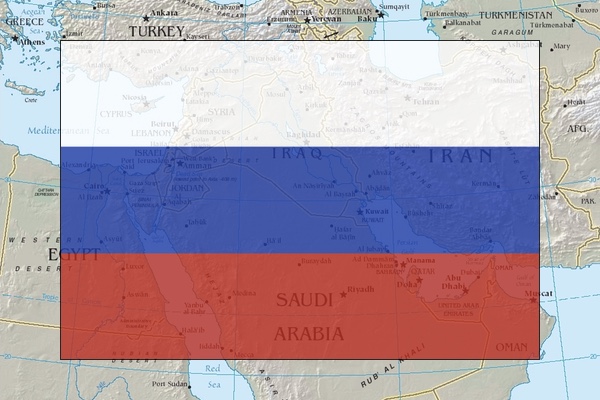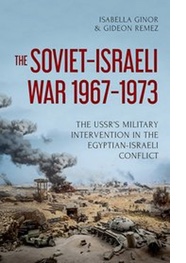The Russian Revolution’s Middle Eastern Legacy: Plus ça Change…

A Russian fleet comes to the aid of an embattled Middle Eastern ally and introduces ground forces to prevent his looming defeat. A Russian base is effectively established on the Mediterranean littoral.
Syria, 2015?
Yes -- but also Syria, 1773-4. It’s little remembered today that way back then, a 10-ship Russian squadron landed 870 marines in Beirut (now in Lebanon) in support of local clients against the Ottoman Sublime Porte. That’s even before there were US Marines, and 30 years before a handful of them made their Mediterranean debut on “the shores of Tripoli.”
 And,
halfway between those two instances, there was Egypt in the summer of
1967 – when nine ships of the Soviet Navy’s newly inaugurated
Fifth Eskadra
anchored,
with great fanfare, in Alexandria and Port Said. They too landed
marines, who together with the ships’ own guns and missiles held
the line along the Suez Canal until the Egyptian Army could regroup
and rearm – thanks to a massive sea- and airlift of Soviet hardware
– after its defeat by Israel in the Six-Day War and the loss of
Sinai.
And,
halfway between those two instances, there was Egypt in the summer of
1967 – when nine ships of the Soviet Navy’s newly inaugurated
Fifth Eskadra
anchored,
with great fanfare, in Alexandria and Port Said. They too landed
marines, who together with the ships’ own guns and missiles held
the line along the Suez Canal until the Egyptian Army could regroup
and rearm – thanks to a massive sea- and airlift of Soviet hardware
– after its defeat by Israel in the Six-Day War and the loss of
Sinai.
This naval force was in effect the vanguard of some 50,000 Soviet regulars who would see combat against Israel in what we describe in a new book as The Soviet-Israeli War, 1967-1973. It followed the USSR and Egypt’s joint resolve to plan, prepare and ultimately execute an offensive across the canal to regain the lost territory -- and to redeem the prestige of Soviet weapons, as well as Moscow’s credibility as an ally. Meanwhile, the Egyptian harbors became Soviet bases opposite the US Sixth Fleet, just as Latakia and Tartus in Syria have now, and as several airfields did in both cases.
Support of regional clients was not the only aim. In this as in other areas of grand strategy, a distinct continuum runs from the Romanovs through the USSR to post-Soviet Russia. In the Middle East, Putin like Stalin and Brezhnev is just claiming what their country has considered rightfully its own since Catherine the Great. Ideology – whether Orthodox Christian, Marxist-Leninist, or Russian nationalist – played some part in the choice of allies and in winning them over, but it could be very flexible when subordinated to realpolitik.
During the half-century of the Cold War, it became a cliché to recall Alexis de Tocqueville’s prediction in 1835 that America and Russia would become the world’s dominant powers. But he actually thought that each of the ascendant nations was “marked out by the will of Heaven to sway the destinies of half the globe”; the Middle East was, and is, squarely in Russia’s designated half. When de Tocqueville wrote in 1835, Russia had already embarked – literally – on its quest for hegemony in the Mediterranean’s eastern basin. In the 1770s Empress Catherine, in a series of victories over the tottering Ottoman Empire, had conquered ports on the Black Sea and gained passage through the Turkish straits into the warm waters of the Med – which the victorious Russian fleet no longer had to access from the distant, winter-icebound Baltic. She also won her subjects access to Jerusalem and other holy places, thus recognizing Russia’s status as protector of Orthodox Christianity, which would remain basic to Russian claims -- first Tsarist, then ostensibly atheist-Soviet, then again Russian-nationalist. Last year it was all the rage among Middle East mavens to mark the centenary, on 16 May 2016, of the secret agreement between British officer Mark Sykes and French diplomat François Georges-Picot to carve up the Ottoman Empire even before it was brought down by World War I. The pact was actually tripartite: Imperial Russia too was to get part of the Ottoman spoils. The agreement’s map featured an “international,” jointly administered zone in Palestine. So if Sykes-Picot had really shaped the present-day Middle East, as most of the commentaries erroneously claimed, the present quasi-tsar Vladimir -- who takes pride in reigning by grace of the reunited Russian church -- would have officially had a say in Holy Land affairs.
The Bolsheviks scuttled the nefarious imperialist plot by publishing it when they took over on 7 November 1917. But they did not give up on obtaining in the name of revolution what the agreement would have gained for the tsar. Five days before the “October Revolution,” Britain -- whose forces were already closing in on Jerusalem -- had voided Sykes-Picot by unilaterally issuing the Balfour Declaration, whereby “His Majesty's government view with favour the establishment in Palestine of a national home for the Jewish people.”
Palestine would become a British mandate, and Britain would be the Soviets’ main rival in the Middle East for the next 30 years. In Arab societies, however, there was yet little traction for class warfare; briefly, the Comintern’s efforts to export revolution had to rely on Jewish emissaries from Palestine, where the Zionist enterprise was led by Russian-speaking socialists, some of them former revolutionaries in the old country. But Zionism was anathema to Stalin’s domestic nationalities policy, and the two movements were soon estranged.
By 1939, ideology had given way to naked power politics. While carving up Eastern Europe with Nazi Germany in the Molotov-Ribbentrop Pact, the USSR asserted once again its claim of primacy in the Middle East, including control of the straits. When Germany turned against him, Stalin pressed for the same from the western allies – now coming into collision with the United States’ foray into the half-globe that de Tocqueville had assigned to Russia.
After World War II, a renewed Soviet thrust for control of the straits led to the Truman Doctrine of containment – first exercised in Greece and Turkey. Moscow was also blocked in its designs to take over Italy’s former mandate over Libya. The Soviets even bid for Britain’s mandate over Palestine, which Arab-Jewish rivalry was rendering ungovernable, on the pretext that “the USSR can undertake a solution, as it is unbiased toward Jews or Arabs.” Then, 70 years ago on 29 November, the United Nations General Assembly adopted the resolution to partition Palestine into a Jewish state and an Arab one.
In a rare anomaly for the incipient Cold War, both the United States and the Soviet Union voted in favor. We are fellows of an Israeli institute that is named for Harry Truman in recognition of the role he is credited for in determining that vote and the instant US recognition of the Jewish state when it was declared six months later. But Israel’s survival is owed at least as much to Stalin, who after years of persecuting Zionism, astonished the world by overruling Molotov and swinging to support of Jewish statehood.
It wasn’t a new idea: as early as 1823, Count Pavel Pestel had proposed to deport Russia’s “unassimilable” Jews to their ancestral land, where their putative state would amount to Russification. The analogous Soviet aim was to accelerate the declining Britain’s exit from the region and obstruct the ascendant United States from taking its place. Stalin considered, at best, that th0se socialist, Russian-speaking Jewish pioneers in Palestine – who had rallied to support of Moscow when it was attacked by Hitler – would be natural candidates to establish a Soviet satellite. At least, Stalin foresaw that the advent of Israel would ensure perpetual conflict, which the USSR could exploit. He provided vital weapons for Israel in its war of independence – while the United States, fearing exactly the same, imposed an arms embargo.
It was a close call in early Israeli politics, but Stalin was soon disabused of any expectations for a pro-Soviet state and a naval base at Haifa; he was also frightened by Soviet Jewry’s enthusiasm for Israel. His other forecast – perpetual conflict – was borne out, and to make the best of it Israel was again cast as an imperialist lackey. Conversely, the “feudal” Arab regimes’ military failure to overwhelm the far-outnumbered Israelis helped to spark the rise of revolutionary regimes in such countries as Egypt and opened prospects for Moscow. When the Eisenhower Administration flubbed the opportunity to sponsor Egypt’s Aswan Dam, revolutionary President Gamal Abdel Nasser turned east. By 1955 he was firmly in the Soviet orbit (despite suppressing Communism at home). The next year saw another rare US-USSR unison to turn back the Anglo-French-Israeli Suez-Sinai campaign against Egypt. But in Arab eyes, the Soviets got the credit after their nuclear threats forced the Europeans and Israelis into an ignominious withdrawal.
This is when superpower-client alignment in the Middle East began to resemble what it became in living memory. As we found in our previous book, Foxbats over Dimona,the Soviets deliberately instigated another Arab-Israeli crisis and war in May-June 1967 and prepared to intervene directly – this time in order to ensure Israel’s defeat. Moscow’s motives were both regional and global: to reinforce and extend Arab identification with its interests – and to prevent Israel’s becoming a nuclear-armed, pro-western presence on the Soviets’ southern flank, much as Cuba had become for the Americans just five years earlier. It was only the brilliant success of Israel’s preemptive air strike on 5 June 1967 that obviated a Soviet marine landing on Israeli shores, as well as strategic-bomber attacks on Israeli targets including its nuclear facility. Israeli air superiority doomed the armies of Soviet proteges Egypt and Syria.
During its early honeymoon with the USSR, a grateful Israel transferred the extensive properties of the Russian Orthodox church under its control to the “red,” Moscow-based patriarchate – in effect an arm of the KGB. Now, when the USSR severed diplomatic relations, the “religious” mission became the Soviets’ main espionage base –another twist in the tale of aspirations in the Holy Land that went 200 years back.
From ’67 to ’73, the Soviets doubled down on their support for Arab preparations for a rematch with Israel – including, despite Détente, the largest direct military intervention outside the Warsaw Pact before Afghanistan, which is now being replicated to the point of déjà vu in favor of Moscow’s client and base provider in Syria. Alliances may shift, as the relationship with Israel did: Egypt, which after the 1973 war switched to the US camp since it needed Washington for the peace with Israel as much as it needed Moscow for the war, has just allowed the reactivation of two old Soviet bases and bought Russian-built fighter jets for the first time in 4o years. Russia’s present confluence of interests with Iran and its regional proteges is a relatively new development, but the underlying considerations are the same: upholding the Russian mirror-image of the Monroe Doctrine to the best of Moscow’s power. If in this field Russian Communism has left a legacy 100 years after the revolution, it is “more of almost the same.”